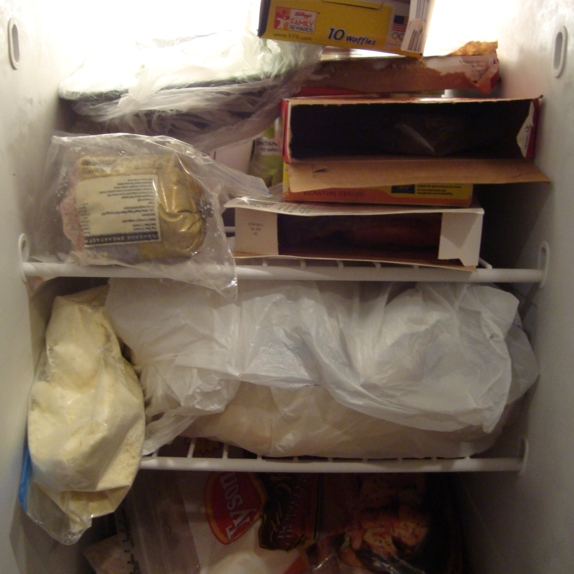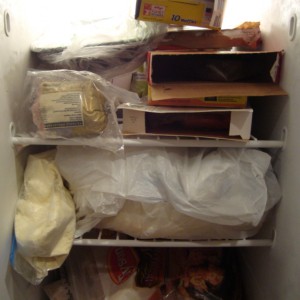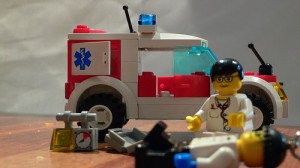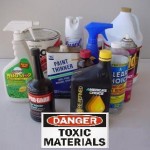
by Angela Hinkle | Mar 13, 2015

UFOs in Your Freezer
Does your kitchen freezer resemble an archaeological dig in an iceberg? Do you ever see what you think is what you’re looking for in the very back? As you reach for it, half of everything else falls out onto your kitchen floor? UFOs (Unidentified Frozen Objects) end up everywhere. Your reaction may be something like, “*#@&!”
This may be a sign that it’s time to organize your freezer. “Are you kidding me? Who has time for that?,”’ you may ask. You might even roll your eyes.
Here are a few tips that may help:
- Clean it out and when in doubt, throw it out.
Start with the hardest part first – trust me, it gets much easier after you’ve completed this step. Go through all the contents of your freezer and throw out what is freezer-burned or otherwise unusable. If you really have no idea if it’s animal, mineral, or vegetable, or how long it’s been in your freezer, it’s time to toss.
If you’ll take a quick moment to label and date the food before you put it in the freezer, you’ll save your sanity later by avoiding guess work. (A friend told me she pulled the plastic tub of fundraiser cookie dough out of the freezer as a treat for her kids. What a surprise to be treated instead to vegetable stew.) Label using wax crayons, pencil, or marker pens on stickers or tape that can stay put in freezing temperatures. And yes, if you are so inclined, there are apps for labeling. By the way, the sniff test is usually useless, since most frozen foods won’t have much of an aroma.
- Freeze in useable portions.
Congratulations! You saved money buying the chicken in that family-sized pack. Keep food safe and manageable by individually wrapping pieces, then freezing in a large, labeled, plastic zip-type bag. Then you only take out the amount you want. You may lose more money than the original savings if you have to thaw out and possibly throw out a gigantic clump of chicken because you only wanted enough for two. Smaller packages also freeze and thaw faster, which saves you time.
Pancakes, berries, broths, meats, nuts, chilies and stews, flour, shrimp, and fish are good choices for freezing. These foods are structurally sound enough to survive the freezer. On the other hand, you’ll want to avoid freezing high-moisture fruits and vegetables like lettuce and watermelon, yogurt, and fried foods. Their textures and appearance tend to turn to, well, yuck.
- Choose the best containers.
We need air to breath, not to circulate around our frozen foods. Air circulating around frozen food can lead to freezer burn – which often makes the food dry and tough. Find containers close to the size of the food you want to freeze. Also, freezing food flat in plastic zipper bags makes them easy to stack.
Remembering to use these tips should help de-stress your life … at least a little. So the next time you’re asked, “What’s for dinner?,” your reply won’t have to be, “We’re having the UFO that fell on my foot.”
For more information on freezing foods, contact your local UF/IFAS Extension Office at http://directory.ifas.ufl.edu/Dir/searchdir?pageID=3&pl=05 and check out these UF/IFAS publications on freezing fruits, http://edis.ifas.ufl.edu/pdffiles/FY/FY72000.pdf, and freezing vegetables, http://edis.ifas.ufl.edu/pdffiles/FY/FY71900.pdf
by Kristin Jackson | Mar 17, 2014

The deadline to enroll in health insurance through healthcare.gov is March 31, 2014
UF IFAS Extension Northwest District cares about you having all the facts necessary to use research based information to make informed choices for you and/or your family. One important choice coming up for almost 70,000 uninsured adults in the Big Bend (Gadsden, Franklin, Jefferson, Leon, Liberty, Madison, Wakulla, Taylor and Dixie Counties) is the decision to obtain health insurance coverage. The deadline to enroll in health insurance through healthcare.gov is March 31, 2014.
Research estimates that the majority of the uninsured are working families with low to moderate incomes, so some individuals and families are unable to pay for health care insurance. The Affordable Care Act gives individuals that are uninsured or underinsured the chance to obtain health insurance or to obtain better insurance. Due to the cost of insurance some low to moderate income individuals may qualify for an exemption, but there are still financial implications for not having health insurance coverage. Five important financial implications of not having insurance are:
1) Out of pocket and are often billed at a higher rate than insured.
2) Financial strain from medical bills and out-of-pocket cost.
3) Inability to pay for their or their family member’s medical care.
4) Compromised credit score.
5) Inability to obtain assets (such as a car or house)
Individuals and families without insurance and who do not have an exemption, will have to pay a penalty. The fine in 2014 will be the greater of $95 or 1% of your yearly household income. The penalty is expected to increase in 2015 and beyond.
If you have additional questions about the Affordable Care Act and would like free research based information contact your local UF/IFAS County Extension Office. Many local UF/IFAS County Extension offices offer information on the Affordable Care Act. You can find your local UF/FAS Extension Office by visiting http://solutionsforyourlife.ufl.edu/map/ or by calling the United Way’s 211 number.
References:
Kaiser Family Foundation. (2013). Key Facts about the Uninsured Population. Retrieved 3 March 2014 from http://kff.org/uninsured/fact-sheet/key-facts-about-the-uninsured-population/
Robert Wood Johnson Foundation. (2013). County Health Rankings & Roadmaps Health Factors Uninsured. ? Retrieved 3 March 2014 from http://www.countyhealthrankings.org/app#/florida/2013/measure/factors/85/data/sort-0
U.S. Centers for Medicare & Medicaid Services. (N.D.) What if Someone Doesn’t Have Health Coverage in 2014? Retrieved 3 March 2014 from https://www.healthcare.gov/what-if-someone-doesnt-have-health-coverage-in-2014/
by Dorothy C. Lee | Oct 24, 2012
 What you don’t know can hurt you. “I didn’t know.” In these words lies the story of countless deaths and injuries in countless homes.
What you don’t know can hurt you. “I didn’t know.” In these words lies the story of countless deaths and injuries in countless homes.
About one-half of the accidental deaths of children occur in the home— from falls, suffocation/choking, scalding, poisoning, and burning. Elderly persons, likewise, are subject to greater dangers because of infirmities and impaired faculties. Yet the concern about home accidents is not only for the very young or the very old. Accidents at home can strike people of all ages.
Every year, over two million poisonings are reported to Poison Control Centers across the country, and more than ninety percent of those happen in the home. The majority of non-fatal poisonings occur among children younger than six years, and poisoning is one of the leading causes of death among adults.
The medicine cabinet is a favorite attraction for curious young children. It is not enough to put poisons and certain types of medicines on high shelves because exploring children like to climb. Dangerous substances need to be locked up.
A significant number of children are being poisoned by consuming medicines brought into the home by grandparents or visitors. Poisonings also have occurred when youngsters have visited homes where no children live.
Substances which can cause accidental poisoning in children also are found outside the medicine cabinet. The list is a lengthy one—detergents, cleaning compounds, insect sprays, paint thinners, and antifreeze, just to name a few.
Children are not the only victims of accidental poisoning. Every year, there are numerous cases of men and women who poison themselves unintentionally. To help prevent a tragic accident in your home, follow safety-wise guidelines.
Keep household products separated. Take care that foods are not exposed and become contaminated when you use insect sprays, cleaning agents, and rodent poisons.
- Containers with flammable liquids should be clearly labeled.
- Flammable liquids such as gasoline should be stored in a cool, well-ventilated place, not inside the home.
- Never pour flammable liquids down sinks or other drains.
- Store medicines and cleaning supplies in locked cabinets out of children’s reach.
The Centers for Disease Control report that about 12,000 children every year are victims of poisonous plants or berries they have ingested, or in some cases, just put into their mouths. Most persons are reasonably familiar with dangerous outdoor plants, such as poison ivy, oleander, or deadly nightshade, but what they do not know is even some of the most common houseplants can cause serious, even fatal reactions. For example, tea brewed from mistletoe berries is lethal and rhubarb leaves (not the stalks) contain oxalic acid, which can cause severe kidney damage.
One home safety issue that is not well-publicized regards pressurized containers. Pressurized containers have revolutionized packaging economy, but caution is necessary in their use. Never incinerate a pressurized container. The heat will cause the air inside to expand, which, in turn, may cause the container to burst. Read the warning message on the container to find out if the mixture is flammable. Keep pressurized containers away from children.
Keeping home safety in mind at all times can mean the difference between a happy home environment and a tragedy.
Note: See the following article for additional information on home safety and children, http://www.nanny.net/blog/9-most-common-household-poisons/




